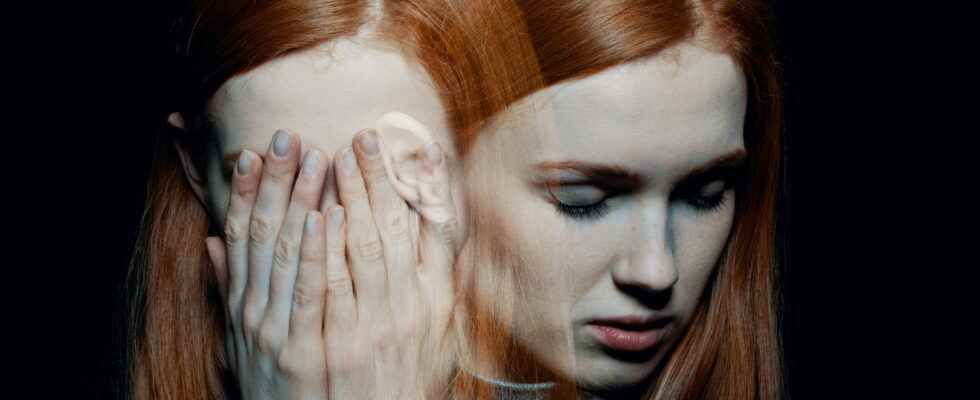A mood disorder results in excessive sadness or elation, often associated with other physical and cognitive symptoms. What are the main mood disorders? How to diagnose and manage them?
Definition: what is a mood disorder?
called mood disorder any abnormal manifestation related to an individual’s mood. It is also referred to as affective mood disorder. Mood disorders are quite numerous. The most common are the depression and bipolar disorder. Mood disorders are frequently associated with addiction issues (drugs, alcohol, benzodiazepines). Women are more affected by mood disorders than men, especially for depression. “Mood is a affective disposition that colors what we live, what we do and what we think in a pleasant or unpleasant way. Mood takes on a triple dimension with the emotional aspect, the physical aspect (pain, sleep and appetite disturbances), and the cognitive aspect (difficulty thinking, concentrating, thinking). Mood Disorders Affect These Three Fields“, comments Dr. Hélène Richard-Lepouriel, psychiatrist.
Are mood disorders recognized by the DSM5?
In the DSM4 there was a large category called mood disorders which included depression and bipolar disorders. In the DSM5, mood disorders are split into two distinct categories: bipolar disorders and depressive disorders. The phrase “mood disorders” no longer appears.
What is the list of mood disorders?
Mood disorders are divided into two groups:
► Bipolar Disorders : these are people who, at certain times in their lives, will have depressive episodes, feel sad, anxious, sometimes have suicidal thoughts, experience difficulty falling asleep, lose weight. Then, at other times, they will present an exaltation of mood (hypomania or mania), the opposite of the depressive phase. They are fit, very euphoric, very confident, think and talk fast, sleep little and have a lot of energy. “Contrary to popular belief, bipolarity does not correspond to a permanent oscillation between these two states, as would a so-called “mounatic” person or suffering from emotional dysregulation who would change their emotional state from one minute to the next. These phases take place over a long period and are interspersed with phases of stability“, nuances the psychiatrist.
► Unipolar disorder or major depressive disorder : the subject will do one or more depressive episodes during his life, without ever having episodes of mood elevation.
What causes a mood disorder?
“The notion of causality cannot be applied to mood disorders. Rather, we speak of factors contributing tos”, immediately rectifies the specialist. Several hypotheses are made: phenomena of genetic vulnerability, environmental factors (stress, early childhood trauma, bereavement, unemployment, emotional breakdown) could precipitate the onset of a mood disorder. At the neuroanatomical level, we reason about both the structure and the cerebral connectivity. “There would probably be structures that would be altered in people with mood disorders (especially the amygdala which manages the emotional aspects) and functional changes. another track, monoaminergic alterations with serotonin, dopamine and norepinephrine, the three major neurotransmitters that would be involved. Other theories around inflammation or oxidative stress are advanced. There is a vast field of exploration but not enough data to currently define precise causes and have diagnostic markers other than clinicals,” she continues.
Who to consult in case of mood disorder?
In first intention, the general practitioner. The latter are better and better trained to diagnose a depressive episode and treat it when it is not yet too severe. If he deems it necessary, he can direct his patient to a psychiatrist.
The diagnosis of a mood disorder is essentially clinical. There is no imaging or plasma biomarker yet. The psychiatrist assesses the symptoms, their duration, intensity and impact on the daily life of the patient.
The management of an acute episode consists of stabilizing the mood and preventing the risk of relapse, which is very important. “In practice, mood stabilizer therapy is administered for bipolar disorder and antidepressant treatment is prescribed for depressive episodes of moderate to severe intensity. The psychoeducation is also essential: having a good knowledge of what the disease is, of the way in which one can act is essential. Psychotherapeutic work is also recommended“, explains Dr. Hélène Richard-Lepouriel. In all cases, the treatment will be adjusted according to the evolution of the mood disorder in question.
Thanks to Dr. Hélène Richard-Lepouriel, psychiatrist in charge of the HUG Mood Disorders Unit.
